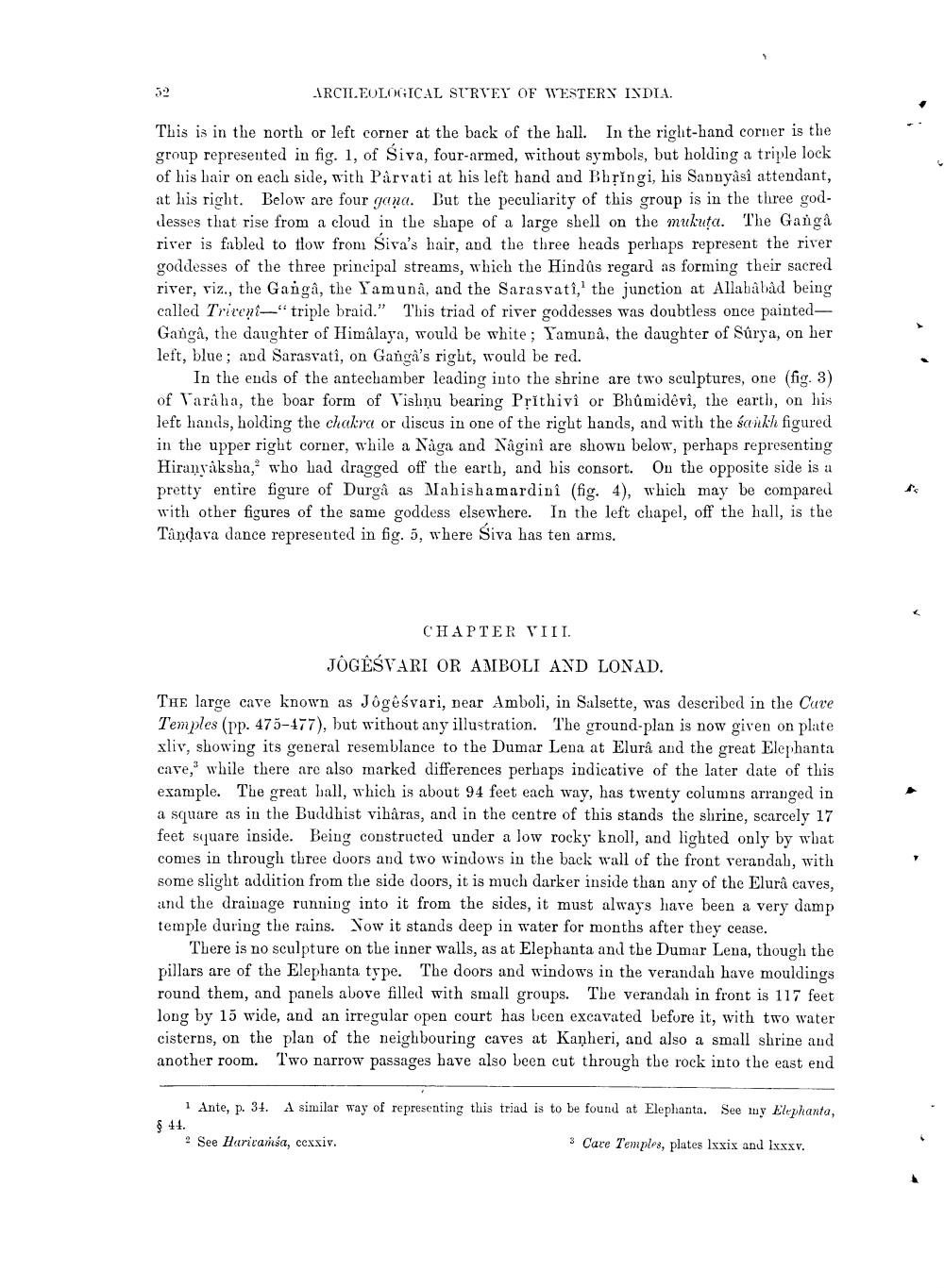________________
52
ARCILEOLOGICAL SURVEY OF WESTERN INDIA.
This is in the north or left corner at the back of the hall. In the right-hand corner is the group represented in fig. 1, of Siva, four-armed, without symbols, but holding a triple lock of his hair on each side, with Pârvati at his left hand and Bhringi, his Sannyasî attendant, at his right. Below are four gana. But the peculiarity of this group is in the three goddesses that rise from a cloud in the shape of a large shell on the mukuta. The Gangâ river is fabled to flow from Śiva's hair, and the three heads perhaps represent the river goddesses of the three principal streams, which the Hindûs regard as forming their sacred river, viz., the Gañgà, the Yamuna, and the Sarasvati,' the junction at Allahabad being called Trivent triple braid." This triad of river goddesses was doubtless once paintedGang, the daughter of Himalaya, would be white; Yamuna, the daughter of Súrya, on her left, blue; and Sarasvati, on Ganga's right, would be red.
In the ends of the antechamber leading into the shrine are two sculptures, one (fig. 3) of Varaha, the boar form of Vishnu bearing Prithivi or Bhumidevi, the earth, on his left hands, holding the chakra or discus in one of the right hands, and with the sankh figured in the upper right corner, while a Naga and Nagini are shown below, perhaps representing Hiranyaksha, who had dragged off the earth, and his consort. On the opposite side is u pretty entire figure of Durga as Mahishamardiniî (fig. 4), which may be compared with other figures of the same goddess elsewhere. In the left chapel, off the hall, is the Tândava dance represented in fig. 5, where Śiva has ten arms.
CHAPTER VIII.
JOGESVARI OR AMBOLI AND LONAD.
THE large cave known as Jôgêśvari, near Amboli, in Salsette, was described in the Cave Temples (pp. 475-477), but without any illustration. The ground-plan is now given on plate. xliv, showing its general resemblance to the Dumar Lena at Elurà and the great Elephanta cave, while there are also marked differences perhaps indicative of the later date of this example. The great hall, which is about 94 feet each way, has twenty columns arranged in a square as in the Buddhist vihâras, and in the centre of this stands the shrine, scarcely 17 feet square inside. Being constructed under a low rocky knoll, and lighted only by what comes in through three doors and two windows in the back wall of the front verandah, with some slight addition from the side doors, it is much darker inside than any of the Elurâ caves, and the drainage running into it from the sides, it must always have been a very damp temple during the rains. Now it stands deep in water for months after they cease.
There is no sculpture on the inner walls, as at Elephants and the Dumar Lena, though the pillars are of the Elephanta type. The doors and windows in the verandah have mouldings. round them, and panels above filled with small groups. The verandah in front is 117 feet long by 15 wide, and an irregular open court has been excavated before it, with two water cisterns, on the plan of the neighbouring caves at Kanheri, and also a small shrine and another room. Two narrow passages have also been cut through the rock into the east end
§ 44.
1 Ante, p. 34. A similar way of representing this triad is to be found at Elephanta. See my Elephanta, 3 Care Temples, plates lxxix and Ixxxv.
2 See Hariramsa, cexxiv.




